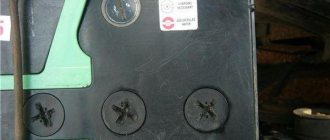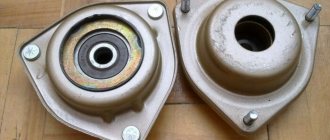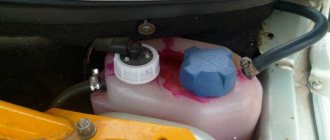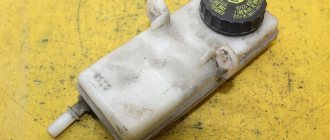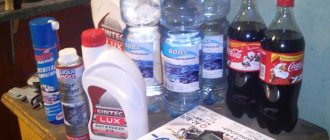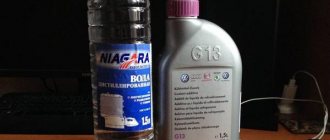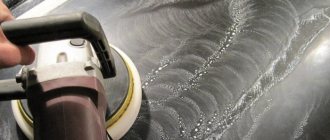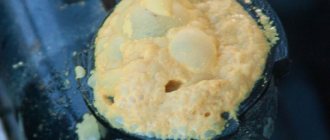The coolant (antifreeze or antifreeze) in the engine cooling system performs the most important function of removing excess heat from heated parts. The coolant also protects the engine cooling system from corrosion, acts as a cleaner for the thin channels of the system, etc. For normal operation of the entire cooling system, antifreeze must be filled strictly to the level.
The following must be taken into account:
- the normal level of antifreeze should be both “cold” and “hot”;
- any deviations from the norm can cause overheating, a significant increase in pressure in the system, rupture of the expansion tank and pipes, etc.
For this reason, it is necessary to know what the level of antifreeze in the tank should be. Read more in our article.
Why check the antifreeze level?
What should the antifreeze level be and how often should I check it? The answer to this question depends on the make and model of the car, any existing faults, and whether the car is new or not. In any case, the driver should not treat his car negligently. If you do not monitor the fluid level, the motor will quickly fail. The fact is that the temperature of a running engine rises greatly, especially in the summer. And in order for the power unit to function properly, the level of antifreeze must be optimal.
Please note : if you want the engine to last a long time, the antifreeze must be in perfect condition.
You should know what the antifreeze level should be because:
- the coolant prevents the power unit from overheating, which means the engine will work properly, without overload;
- antifreeze, moving through a closed system, increases the life of the engine;
- if a coolant leak occurs, it will not be easy to wash the surface of the car;
- If an internal leak occurs when antifreeze enters the cylinders, a water hammer may occur, after which the machine will stop working.
Coolant has a specific smell and a certain shade. Due to the special chemical components included in the antifreeze, it remains in a liquid state even at sub-zero temperatures. His physical condition does not change, no matter how hot or cold it is outside.
I take the cheapest one, it's antifreeze!
To seriously save on antifreeze, use its most expensive part - ethylene glycol. Therefore, to reduce the cost of the product, ethylene glycol is replaced with viscous glycerin diluted with methanol. Glycerin and methanol cause significant damage to modern systems, corroding aluminum and polymers, causing cavitation and boiling off of liquids.
Methanol products on the shelf usually cost up to 300–450 rubles per 5 kg of antifreeze. Up to 600 rubles, there is also a huge chance of stumbling upon a repainted “antifreeze”, which on the label may have the words “Antifreeze”, “G11”, “G12”, “carboxylate”, “Recommended for Audi, BMW, Mercedes”, etc. These inscriptions are solely the opinion of the company’s marketers, which has nothing in common with the truth, since the antifreeze formulation will never pass the tests of the world’s automakers.
Considering that antifreeze is changed every 3-5 years - think about it! Saving 300–400 rubles once in 5 years, you will get either one of these problems, or perhaps all of them:
- pump replacement
- radiator replacement
- 5% increase in fuel consumption
- reduction in the actual life of engine oil by 10–20%
Therefore, it is recommended to choose products that have official antifreeze approvals for your car brand (and sometimes a specific engine). Unfortunately, the choice is not wide - it is either the original antifreeze from the manufacturer, or its rebrand - the same liquid in chemical composition with official confirmation of the presence of all the approvals of the “original”. The first solution is obvious, but not cheap. The second is more economical, but you need to know which brands are the same rebrands.
Now you will not only prevent 7 common mistakes when buying antifreeze, but you will also prevent your friends from doing the same.
How does the engine cooling system work?
Structurally, the cooling system includes the following main elements:
- channels and tubes;
- thermostat;
- expansion tank;
- cooling radiator;
- cooling Fan;
- heater radiator (heater radiator);
- water pump (pump).
There is a constant circulation of antifreeze inside the system due to the operation of the pump. In this case, the volume of liquid supplied to the cooling radiator is regulated by a thermostat depending on the temperature.
While the engine is warming up and has not reached operating temperature, antifreeze circulates only through the engine cooling jacket (channels in the block and cylinder head), that is, in a small circle. After reaching operating temperatures (about 85-90 degrees Celsius), the thermostat opens a channel for liquid to flow into the cooling radiator (large circle).
As a result, after opening the thermostat, antifreeze circulates in a small circle, as well as in a large one at the same time. At the same time, the liquid in the radiator is actively cooled. If such cooling is not enough, the cooling fan is activated, which additionally blows outside the engine.
The danger of insufficient antifreeze levels
During operation, the car engine heats up quickly, and without an effective cooling system, the car could only travel a few kilometers, after which it would be necessary to stop for 15-20 minutes to cool the engine. If the car has any malfunctions in the cooling system, this can lead to thermal deformation of the cylinder head, and such repairs will cost a significant amount.
If the level of antifreeze is insufficient, there is a significant deterioration in the cooling efficiency of the engine; problems may arise in the operation of the pump, which is not lubricated and not cooled; ultimately, the car owner will subsequently face complex repairs. Whereas all such problems could be avoided by promptly checking the coolant level in the system.
A car can lose antifreeze through numerous leaky pipe connections or microdamage in the radiator. In this case, there will be no visible leaks both in the engine compartment and under the car. Therefore, the driver may simply not be aware of any cooling problems he has in his car. It is extremely important to check the coolant level on a regular basis, which will avoid various types of problems with the car.
Origins of the problem
As we already said, car owners usually know what they put into the cooling system. But there are times when the driver does not have reliable information. The following typical situations can be distinguished:
- The used car was recently purchased, but the buyer forgot to ask the former owner about what consumables were used.
- The car was received at work for long-term use. The previous employee could simply quit and not talk about how he serviced the vehicle.
- The driver notices that the cooling system is not working correctly. In this case, you can suspect that the wrong coolant was filled in at the car service center, but this needs to be checked somehow.
What function does antifreeze perform?
First of all, it should be recalled that the word “antifreeze” has foreign roots and is translated as “anti-freeze.” This is how one can characterize its main function. This substance should not freeze even in very frosty winters.
In addition, the coolant performs the following work:
- fast and effective protection of the car engine from overheating during its operation;
- maintaining a high level of anti-corrosion protection for all existing metal parts;
- reliable protection of the cooling system from freezing when using the car in the frosty winter period.
You may also be interested
How to completely drain antifreeze from the cooling system
To ensure efficient operation of the cooling system, you need to change the antifreeze in a timely manner, using consumables that are best suited for a particular brand of car. When performing this type of routine maintenance, it is important to properly drain the waste fluid.
Can antifreeze freeze?
With the onset of cold weather, many drivers are faced with an unexpected phenomenon: antifreeze freezes in the expansion tank of the cooling system. In such a situation, questions arise as to why this happened and how to prevent a similar situation from reoccurring in the future. Our experts will help answer these questions.
What does antifreeze affect?
Interestingly, the engine cooling solution expands like any other liquid. Its excess is sent to the expansion tank, which can be found under the hood. This process allows you to maintain the balance necessary for the normal operation of the power unit. The tank itself has special marks, and this is for a reason. Both a lack and an excess of coolant are equally dangerous for a car. For example, during the movement of antifreeze, the risk of formation of vapor locks, which can damage the engine, is reduced. If there is a lack of refrigerant, the engine overheats greatly, and this can disrupt the temperature regime of the cylinder head. In turn, the oil channels may collapse, and fuel consumption will probably creep up. The result may be “capital”. That is why it is necessary to ensure that the optimal level of antifreeze in the expansion tank is maintained.
What is antifreeze?
An attentive car enthusiast will probably notice that the coolant can have different colors, for example, red or green. The logical question is: is it possible to mix products with different shades? The answer is obvious - in no case, because this can significantly reduce the effectiveness of the final mixture. It is worth understanding that color is the result of adding dye. The main components have a completely different meaning. For example, most antifreeze is propylene or ethylene glycol (approximately 95%). The remainder is taken up by water and numerous additives. Perhaps the most important of them are corrosion inhibitors, which protect the unit itself and its elements from rust.
How to quickly distinguish fake antifreeze or antifreeze
Good afternoon everyone. In this article we will look at how easy it is, that is, at home or in the garage, to distinguish counterfeit antifreeze from normal antifreeze.
There are simply a huge number of videos on the Internet where they boil it, set it on fire, freeze it, and so on, but there is one effective and simple method. You can easily check antifreeze or antifreeze at home with your own hands.
We will check all colors of antifreeze, that is, whether this method works on all antifreezes or only a certain color, as well as on antifreeze.
Here are the cups filled with different brands of antifreeze.
Here the essence is what, usually antifreeze or antifreeze is made on the basis of propylene glycol or ethylene glycol - these are the simplest alcohols in our country, they do not allow the liquid to freeze at -20, at -30 degrees, but careless sellers add acid instead of ethylene glycol or propylene glycol, I don’t know what kind of acid, sulfuric roofing felts or something else, they are also diluted with distilled water, dyes are added and this liquid also does not freeze down to -20 -30 degrees.
Stores sell it to us under the guise of antifreeze, and such a liquid is about 3-4 times cheaper than those based on ethylene glycol or propylene glycol.
And also, such a liquid is very dangerous for your car; if you pour this liquid into a car, then over time it will begin to corrode the inside of the block, the block head, in short, wherever there are channels through which antifreeze circulates.
The head gasket corrodes precisely because of this antifreeze, and people wondered why it corrodes? The pump, radiator pipes, etc. are also eaten.
And you can check it easily and simply using regular baking soda. Ethylene glycol or propylene glycol do not react with soda, that is, the soda will fall and just lie on the bottom, but fake antifreeze, which is made with acid, will react violently.
Let's check.
Take some baking soda and add it to a glass of antifreeze.
Look, the soda has precipitated, absolutely nothing happens - this is normal antifreeze.
We take antifreeze, also throw in a little soda, look, there is absolutely no reaction, which means the antifreeze is genuine, normal.
Now let's throw soda into the fake antifreeze,
look at the foam and whispers.
Under no circumstances should you fill it, look at how much foam it has.
and this foam will not go away until the soda completely breaks down, that is, we will not have any sediment below.
Coolant: antifreeze level
The engine cooling system is closed and completely sealed. In this case, the level of antifreeze plays a vital role in the system, since an insufficient level of antifreeze or antifreeze will lead to overheating of the engine. In turn, strong overflow can cause leaks, rupture of pipes or expansion tank.
- For this reason, it is important to maintain optimal antifreeze levels. The volume of liquid is determined using an expansion tank, into which coolant is poured when filling the system. As a rule, there are “min” and “max” inscriptions on the tank, indicating the minimum and maximum fluid levels in the cooling tank.
- The norm is considered to be when the system is filled with high-quality ready-made antifreeze, the level of which is between the indicated marks. If there are no marks, then the middle of the tank is considered the norm (you can measure the total depth of the tank with a ruler).
- It is important to take into account that the level of antifreeze changes during heating and cooling. For this reason, you need to remember that the “cold” coolant level and the “hot” coolant level will be different.
In practice, if you fill the cold tank almost to the maximum, after warming up the liquid level will exceed the norm. Also, if you pour to a minimum (adjusted for heating), after warming up the liquid may not be enough for the entire system to operate most efficiently. This means that during operation it is advisable to determine how much the level rises when hot on a particular car.
Taking into account the fact that often when fully warmed up, the liquid in the tank rises from the average level closer to the maximum, experienced drivers add antifreeze to the cold one so that its level is slightly below the average level. Subsequently, after warming up, the level rises and will remain above average, but not exceed the maximum permissible.
Errors when handling antifreeze and their consequences
When checking the antifreeze level in the tank, it often becomes necessary to top it up. In winter, it evaporates intensely, so you need to check its condition more often at this time. At low temperatures, all elements of the expansion tank partially lose their tightness, as the properties of rubber and plastic change. This is fraught with antifreeze leaks. As a rule, they are not fatal, but this does not eliminate the need to monitor the process and timely add a new portion of antifreeze.
Typical mistakes when handling antifreeze are:
- the plug is unscrewed “hot”, without waiting for the engine to cool down;
- there is no rag on the tank (if the tank has not had time to cool completely, this can be dangerous);
- fresh liquid is added “to the hot one;
- antifreeze is poured into an empty container;
- do not use distilled water, but ordinary water when topping up.
No matter what frivolous “experienced” drivers say, you cannot unscrew the cap when the engine is hot. Even if the brave souls are constantly lucky, it is not a fact that next time everything will be exactly the same. Since the pressure in a closed system is high, when you unscrew the cap “hot,” the liquid may splash out onto your hands or even onto your face. Serious burns always leave scars, so there is no need to rush and tempt fate.
There are situations when there is no time to wait until the system has completely cooled down. In this case, place a rag over the lid before unscrewing. It will close the drain hole and prevent a strong splash of antifreeze, but will not be able to protect against splashes. To avoid injury, it is better, however, to wait until the engine has completely cooled down and only then get to work.
The fluid level in the expansion tank cannot be checked “hot”. Never add new antifreeze until the system has completely cooled down. Remember that when warming up, there is a risk of overfilling the maximum level, squeezing antifreeze into the space under the hood of the car and damaging its internal parts.
Important! The tank should not be allowed to become completely empty. When adding antifreeze to an empty container, air may enter the system along with it. The engine will overheat and fail. If the tank still turns out to be empty, fresh antifreeze must be filled at a service station.
All instructions for using antifreeze state that in the absence of a suitable liquid, distilled water can be added. Ordinary water is added only in emergency cases, and when it becomes possible to contact a service station, this must be done as quickly as possible. You cannot constantly use plain water: an increased content of mineral deposits in it will lead to the appearance of rust inside the engine and other elements of the car.
What do the marks on the expansion tank mean?
The above liquid is poured into the expansion tank of the cooling system. To determine the amount of liquid on the tank body there are two marks showing the minimum and maximum points. It is from these two marks that the motorist concludes that it is necessary to timely add antifreeze to the required level. It is very important to remember that when assessing the fluid indicator, the car must be on a flat section of the road. Otherwise, the label will show the incorrect volume of liquid.
How to check antifreeze for freezing
Checking antifreeze with a car hydrometer
It is impossible to check the temperature of antifreeze at which it will freeze in a regular freezer, because it will not be possible to cool the liquid in it below -21°C. The freezing point of antifreeze is calculated by its density. Accordingly, the lower the density of antifreeze (up to approximately 1.086 g/cm³), the lower the freezing temperature will be. Density and, accordingly, freezing point are measured using a hydrometer. They come in two types: household (medical) and special automotive. Household hydrometers are usually of the submersible type. On their side surface there is a scale with the corresponding density values (usually in g/cm³). Which is the best hydrometer to choose for checking antifreeze, see here.
How to check antifreeze with a hydrometer
A car hydrometer is a plastic bottle (or glass tube) with a rubber hose and a bulb attached to the neck. It can be used to take antifreeze samples directly from the radiator. On the side of the bottle there is a scale with direct information about the freezing temperature. Density values and temperature values can be found in the table.
| Antifreeze density, g/cm³ | Antifreeze freezing point, °C |
| 1,115 | –12 |
| 1,113 | –15 |
| 1,112 | –17 |
| 1,111 | –20 |
| 1,110 | –22 |
| 1,109 | –27 |
| 1,106 | –29 |
| 1,099 | –48 |
| 1,093 | –58 |
| 1,086 | –75 |
| 1,079 | –55 |
| 1,073 | –42 |
| 1,068 | –34 |
| 1,057 | –24 |
| 1,043 | –15 |
Checking the tightness of the plug and tank
As a result of shaking and constant movement, the valve can rust - as a result of constant contact with the liquid. To prevent leaks, you need to regularly check what condition it is in. Like topping up, checking the plug should be done only after the engine has completely cooled. The valve is inspected and screwed back in. If it does not tighten well, it should be changed.
You can check the tightness of the container using a stand. Usually, this is done at service stations, but if you wish, you can organize such a test yourself. The tank is carefully removed from the car. It has three holes. Two of them are turned off, and the remaining one is supplied with air by a pump to inflate the tires. The plug should be tightly screwed during testing. If, when creating high pressure inside the container, the valve allows air to pass through, it must be urgently changed.
If the valve maintains a pressure of 1.3 to 2 atmospheres, it is also inoperative. The optimal indicator of the good condition of the plug is when, at a pressure of 1.4 atmospheres or more, it opens and releases excess pressure.
After disconnecting the pump, the pressure in the tank must be maintained: this ensures that the tank is in order and ready for further use.
What are the dangers of too little or too much coolant?
If there is insufficient coolant, the engine overheats, the pressure in the system increases, and air may begin to enter the system, which increases the likelihood of antifreeze splashing out or pipes breaking.
If there is too much coolant, when it heats up and expands, it foams heavily and can knock out the reservoir cap.
Antifreeze is always the right choice
TOSOL is one example of how a trademark has become a category name by analogy with Xerox and “copiers”, Scotch adhesive tape and “scotch tape”, etc. TOSOL is a trademark of the Institute of Organic Synthesis, the name of which is formed from the words Technology of Organic Synthesis "tos-" and the typical ending of organic compounds - "-ol" (ethanol, methylbutanol, etc.).
This is a recipe from the 70s, developed in the USSR for engines of those times based on cast iron (block) and loads typical for units of that time. If we are talking about any modern engine that uses aluminum or other non-ferrous metal, or even more so about forced engines (turbocharged systems), “antifreeze” is something that simply cannot be used in such systems. Corrosion, cavitation, deposits in the system - all this awaits those who pour antifreeze even into a new LADA car (the engines of which, by the way, use carboxylate antifreeze).
Therefore, forget the word “antifreeze”. It doesn’t matter how old your car is, there is no point in buying antifreeze when you can buy orders of magnitude more advanced products - for example, carboxylate or lobride antifreezes approved for your car.
Checking antifreeze leaks
You can check where the antifreeze is leaking on any car using one of three methods:
Cover for creating excess pressure in the system
- Visual inspection. The simplest, but not very effective method, since with its help you can only find significant leaks.
- Check with liquid under pressure. To perform this, the antifreeze is completely drained from the cooling system, and water under pressure is pumped in instead. Excess pressure will most likely show where the leak was.
- Ultraviolet search. Many modern antifreezes contain fluorescent additives (or you can add them to the liquid yourself), which become visible when you shine an ultraviolet flashlight on them. Therefore, at the slightest leak, you will see a glowing trace.
At home, there is one proven life hack on how to check where antifreeze is flowing using a car compressor. It consists of taking an old similar plug from the expansion tank, drilling it and inserting the nipple from the wheel (fastening it tightly). Next, put the cap on the expansion tank and use an air compressor to create excess pressure in the system, but NOT MORE THAN 2 atmospheres! A very effective method!
